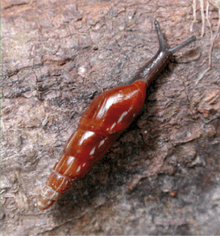Laevaricella perlucens
| Laevaricella perlucens | |
|---|---|
 | |
| Laevaricella perlucens | |
| Conservation status | |
| NE[1] | |
| Scientific classification | |
| Kingdom: | Animalia |
| Phylum: | Mollusca |
| Class: | Gastropoda |
| (unranked): | clade Heterobranchia
clade Euthyneura |
| Superfamily: | Testacelloidea |
| Family: | Oleacinidae |
| Subfamily: | Varicellinae |
| Genus: | Laevaricella |
| Species: | L. perlucens |
| Binomial name | |
| Laevaricella perlucens (Guppy, 1868)[2] | |
| Synonyms | |
|
Glandina perlucens Guppy, 1868 | |
Laevaricella perlucens is a species of tropical, air-breathing land snail, a terrestrial pulmonate gastropod mollusk in the family Oleacinidae.
Distribution
Laevaricella perlucens is endemic to Dominica.[3] The type locality is "on Morne Diablotin, the north end on the island", Dominica.[2]
Laevaricella perlucens is very restricted in range[3] and probably meet the IUCN-criteria of Critically Endangered species.[3]
Description
Laevaricella perlucens was originally discovered and described (under the name Glandina perlucens) by British-born naturalist Robert John Lechmere Guppy in 1868.[2]
Guppy's original text (the type description) reads in Latin language and in English language as follows:
| “ |
Glandina perlucens, n. sp. Testa subulate-turrita, laevis, diaphana, fusco-flavida, vix striatula, lineis distautibus ornata; apex obtusissimus; anfractus 7, parum convexi, lente accrescentes, ultimas applanatus, spirse longitudinem circiter sequans; sutura valde impressa; columella valde torta, truncata; peristoma simplex, margine externo aliquanto prominente. Long, 16 millim., lat. maj. 4 millim.; apart, alt. 4, lat. 2. A subulate-turrite, smooth, brilliantly polished, yellowish-red shell, marked by obscure striae and by distant variciform lines, of which there are from three to six on a whorl; with a very obtuse apex and seven slowly increasing, scarcely convex whorls, the last somewhat flattened and equal to about half the length of the shell; columella strongly curved, truncate; aperture oval, elongate; peristome simple, its external margin somewhat prominent. A species allied to G. afrcuata., Pf., of Jamaica. Of three examples I obtained, one only was of full growth. |
” |
This species had never been collected since it was described by Guppy (1868)[2] until 2009 and his type material was subsequently lost.[3] The single specimen collected alive in 2009 allowed figure this species for the first time.[3]
Ecology
This species is restricted to higher localities.[3] It does not occur, however, on the upper slopes of the higher peaks, but it seems to be restricted to the hygrophytic vegetation zone (cloud forest).[3]
References
This article incorporates public domain text from the reference [2] and CC-BY-3.0 text from the reference.[3]
- ↑ IUCN 2010. IUCN Red List of Threatened Species. Version 2010.4. <www.iucnredlist.org>. Downloaded on 5 December 2010.
- ↑ 2.0 2.1 2.2 2.3 2.4 Guppy R. L. M. (1868). On the terrestrial mollusks of Dominica and Grenada, with an account of some new species from Trinidad. Annals and Magazine of Natural History (4)1: 429-442. page 430.
- ↑ 3.0 3.1 3.2 3.3 3.4 3.5 3.6 3.7 Robinson D. G., Hovestadt A., Fields A. & Breure A. S. H. (July 2009). "The land Mollusca of Dominica (Lesser Antilles), with notes on some enigmatic or rare species". Zoologische Mededelingen 83 http://www.zoologischemededelingen.nl/83/nr03/a13